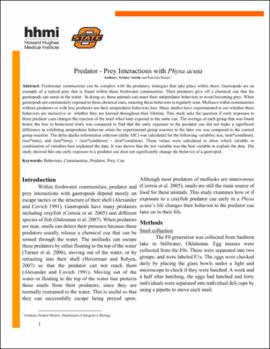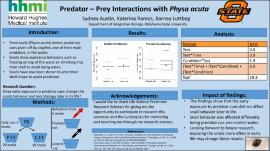| dc.contributor.advisor | Ramos, Katerina | |
| dc.contributor.author | Austin, Sydney | |
| dc.contributor.other | HHMI Life Science Freshman Research Scholars | |
| dc.date.accessioned | 2019-07-22T17:02:48Z | |
| dc.date.available | 2019-07-22T17:02:48Z | |
| dc.date.issued | 2019-04-27 | |
| dc.identifier | oksd_hhmi_2019_austin | |
| dc.identifier | oksd_hhmi_2019_austin_poster | |
| dc.identifier.citation | Austin, S., & Ramos, K. (2019, April 27). Predator-prey interactions with Physa acuta. Paper presented at the HHMI Life Sciences Freshman Research Scholars Symposium, Stillwater, OK. | |
| dc.identifier.uri | https://hdl.handle.net/11244/321017 | |
| dc.description.abstract | Freshwater communities can be complex with the predatory strategies that take place within them. Gastropods are an example of a typical prey that is found within these freshwater communities. Their predators give off a chemical cue that the gastropods can sense in the water. In doing so, these animals can enact their antipredator behaviors to avoid becoming prey. When gastropods are continuously exposed to these chemical cues, enacting these behaviors is regularly seen. Molluscs within communities without predators or with less predators use their antipredator behaviors less. Many studies have experimented to see whether these behaviors are instinctive or whether they are learned throughout their lifetime. This study asks the question if early exposure to these predator cues changes the reaction of the snail when later exposed to the same cue. The average of each group that was found below the line in behavioral trials was compared to find that the early exposure to the predator cue did not make a significant difference in exhibiting antipredator behavior when the experimental group reaction to the later cue was compared to the control group reaction. The delta akaike information criterion (delta AIC) was calculated for the following variables; test, (test*condition), (test*time), and (test*time) + (test*condition) + (test*condition). These values were calculated to show which variable or combination of variables best explained the data. It was shown that the test variable was the best variable to explain the data. The study showed that one early exposure to a predator cue does not significantly change the behavior of a gastropod. | |
| dc.description.sponsorship | Howard Hughes Medical Institute Science Education Program | |
| dc.format | application/pdf | |
| dc.language | en_US | |
| dc.publisher | Oklahoma State University | |
| dc.rights | In the Oklahoma State University Library's institutional repository this paper is made available through the open access principles and the terms of agreement/consent between the author(s) and the publisher. The permission policy on the use, reproduction or distribution of the article falls under fair use for educational, scholarship, and research purposes. Contact Digital Resources and Discovery Services at lib-dls@okstate.edu or 405-744-9161 for further information. | |
| dc.title | Predator-prey interactions with Physa acuta | |
| osu.filename | oksd_hhmi_2019_austin.pdf | |
| osu.filename | oksd_hhmi_2019_austin_poster.pdf | |
| dc.description.department | Integrative Biology | |
| dc.type.genre | Research report | |
| dc.type.genre | Presentation | |
| dc.type.material | Text | |
| dc.subject.keywords | behaviors | |
| dc.subject.keywords | communities | |
| dc.subject.keywords | predator | |
| dc.subject.keywords | prey | |
| dc.subject.keywords | cue | |

